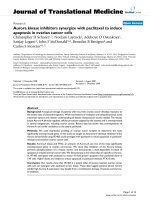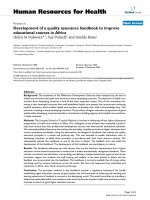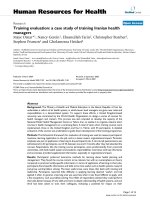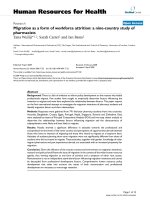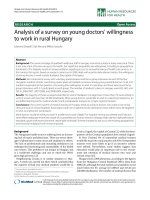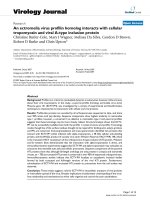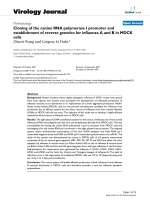Báo cáo sinh học: "Aurora Kinase A expression is associated with lung cancer histological-subtypes and with tumor de-differentiation" doc
Bạn đang xem bản rút gọn của tài liệu. Xem và tải ngay bản đầy đủ của tài liệu tại đây (1.05 MB, 6 trang )
RESEARCH Open Access
Aurora Kinase A expression is associated with
lung cancer histological-subtypes and with tumor
de-differentiation
Marco Lo Iacono
*
, Valentina Monica, Silvia Saviozzi, Paolo Ceppi, Enrico Bracco, Mauro Papotti and
Giorgio V Scagliotti
Abstract
Background: Aurora kinase A (AURKA) is a member of serine/threonine kinase family. Several kinases belonging to
this fami ly are activated in the G2/M phase of the cell cycle being involved in mitotic chromosomal segregation.
AURKA overexpression is significantly associated with neoplastic transformation in several tumors and deregulated
Aurora Kinases expression leads to chromosome instability, thus contributing to cancer progression. The purpose of
the present study was to investigate the expression of AURKA in non small cell lung cancer (NSCLC) specimens and
to correlate its mRNA or protein expression with patients’ clinico-pathological features.
Materials and methods: Quantitative real-time PCR and immunohistochemistry analysis on matched cancer and
corresponding normal tissues from surgically resec ted non-small cell lung cancers (NS CLC) have been performed
aiming to explore the expression levels of AURKA gene.
Results: AURKA expression was significantly up-modulated in tumor samples compared to matched lung tissue
(p < 0.01, mean log2(FC) = 1.5). Moreover, AURKA was principally up-modulated in moderately and poorly
differentiated lung cancers (p < 0.01), as well as in squamous and adenocarcinomas compared to the non-invasive
bronchioloalveolar histotype (p = 0.029). No correlation with survival was observed.
Conclusion: These results indicate that in NSCLC AURKA over-expression is restricted to specific subtypes and
poorly differentiated tumors.
Background
Aurora kinase A (AURKA) is a member of serine/threo-
nine kinase family: homologous to both the Drosophila
aurora and Saccharomyces cerevisiae Ipl1 kinase
families. It plays an important role in completing mitotic
events such as centrosome separation, bipolar spindle
assembly, chromosome s egregation and cytokinesis [1].
Aurora A expression is cell-cycle regulated. Indeed its
mRNA, protein levels and kinase activity are low in the
G1/S phase; it accumulates during G2/M and decreases
rapidly after mitosis. Aurora A protein is localized in
the centrosomes of interphase cells and in the spindle of
mitotic cells. Ectopic expression of Aurora A leads to an
increase in centrosome numbers, causes catastrophic
loss or gain of chromosomes, and results in either cell
death or survival through malignant transformation [2].
Over-expression of AURKA has been detected in many
tumor cells and tissues, such as breast, gastric, colorec-
tal, bladde r, pancreatic, ovarian, prostate and lung can-
cers [3-8]. Previous data has pointed out that AURKA
over-expression is associated with the carcinogenesis
and/or drug resistance in many human malignant
tumors. Indeed, AURKA phosphorylates p53, abrogates
both p53 DNA binding and transactivation acti vities. In
such context, AURKA overrides the apoptosis and cell
cycle arrest induced by cisplatin and g-irradiation,
respectively [9].
AURKA over-expression was also correlated with clinical
stage and metastasis and its inhibitions to reduce cell inva-
sion in vivo [10,11]. However, AURKA expression was
involved in the epithelial-mesenchimal transition (EMT)
of nasopharyngeal carcinoma. Indeed, the inhibition of
* Correspondence:
Department of Clinical and Biological Sciences, University of Turin, Turin, Italy
Lo Iacono et al. Journal of Translational Medicine 2011, 9:100
/>© 2011 Lo Iacono et al; licensee BioMed Central Ltd. This is an Open Access arti cle distributed under the terms of the Creative
Commons Attribution License ( which permits unrestricted use, distribution, and
reproduction in any medium, provided the original work is properly cited.
AURKA suppresses inva sion and increases the expression
of different epithelial markers [12].
The aim of the present study was to investigate the
AURKA expression levels in lung tumors and their cor-
responding morphologically normal lung tissues,
obtained from the same resected lobe in patients with
early stage NSCLC. Correlation between AURKA
expression, patients’ clinicopathological features and sur-
vival was assessed.
Materials and methods
Patients and samples
Frozen primary lung tumor and corresponding non-neo-
plastic lung specimens of 83 consecutive NSCLC
patients who un derwent radical surgery at the San Luigi
Hospital, Division of Thoracic Surgery, between Decem-
ber 2003 and March 2005, were analyzed.
Patients (64 males and 19 females) had a median age
of 67 years (range 40 to 82 years) and no patient
received either pre-operative or post-operative chemo
and/or radio-therapy according to the institutional treat-
ment policy for resectable rescue in those years. Histolo-
gical examination was performed on formalin-fixed
tissues in all cases and tumors were diagnosed and clas-
sified according to the WHO classification [13] as
follows:
40 adenocarcinomas (ADC); 30 squamous cell carci-
nomas (SQC); 4 large cell carcinomas (LCC); and 9
bronchiolo-alveolar carcinoma/adenocarcinoma in si tu
(BAC/AIS). Differentiation grade (grade 1: 16, grade 2:
29, grade 3: 38), pT status (pT1: 7, pT2: 59, pT3: 9,
pT4: 8) and pN status (pN0: 52, pN1: 13, pN2: 18) were
also recorded. According to the TNM classification for
solid tumors [14], 41 cases had a pathological stage I; 15
stage II; 24 stage III; and 3 stage IV. Follow up data was
available for all c ases. Informed con sent was obtained
from each patient and the study was approved by the
Institution al Review Board of the San Luigi Hospital. All
samples were de-identified and cases anonymized by a
pathology staff member not involved in the study. C lini-
cal parameters were compared and analyzed through
coded data.
RNA extraction, cDNA synthesis and Qpcr
RNA was extracted from 15-25 mg and 60-80 mg of
tumor and normal lung t issue specimens, respectively.
Genomic DNA contamination was remove d by DNAseI
treatment (Promega). TotRNA was then quantified with
an Agilent 2100 Bioanalyzer (Agilent Technologies, Palo
Alto, CA) and stored at -80°C. Two μgtotRNAwere
retro-transcribed with random hexamer primers and
Multiscribe Reverse transcriptase (High Capacity cDNA
Archive Kit, Applied Biosystems, Foster City, CA), in
accordance with manufacturer’s suggestions.
Expression levels of AURKA and of reference gene s
POLR2B and ESD were evaluated with SYBR technology
with optimized PCR conditions and primer concentra-
tions. Primer sequences were as follows: AURKA.FW:
GAGATTTTGGGTGGTCAGTAGATG, AURKA.RW:
TAGTCCAGCGTGCCACAGAGA, ESD.FW:TGTTGTC
ATTGCTCCAGATACCA, ESD.RW:CCCAGCTCTCAT
CTTCACCTTT, POLR2B.FW:CCTGATCATAACCAG
TCCCCTAGA,OLR2B.RW:GTAAACTCCCATAGCCT
GCTTACC.
Melting curve analysis and efficiency evaluations were
performed for all the amplicons. Quantitative PCR (qPCR)
was carried-out on an ABI PRISM 7900 HT Sequence
Detection System (Applied Biosystems) in 384-well plates
assembled by Biorobot 8000 (Qiagen, Germantown, ML).
Reactions were performed in a final volume of 20 μl. All
qPCR mixtures contained 1 μl of cDNA template, 1Х
SYBR Universal PCR Master Mix (2×) (Applied Biosys-
tems). Cycle conditions were as follows: after an initial
2-min hold at 50°C to allow AmpErase-UNG activity, and
10 minutes at 95°C, the samples were cycled 40 times at
95°C for 15 seconds and 60°C for 1 minute . Baseline and
threshold for Ct calculation were set-up manually with the
ABI Prism SDS 2.1 software.
Immunohistochemistry
Formalin-fixed paraffin-embedded tissues were cut into 4
μm thick sections and collected onto charged slides for
immunohistochemical staining. After de-paraffination and
rehydration through graded alcohols and phosphate-buf-
fered saline (pH 7.5), the endogenous peroxidase activity
was blocked by incubation with absolute methanol and
0.3% hydrogen peroxide for 15 minutes. Sections were
incubated at the optimal conditions with the following pri-
mary antibodies:
(1) mouse monoclonal antibody anti-Ki67 (1:300;
MIB-1, DakoCytomation, Glo strup, Denmark); (2)
Mouse monoclonal AURKA (1:200; H00006790-M01,
Abnova, Taipei, Taiwan).
Immun oreaction was revealed by a dextran-chain (bio-
tin-free) detection system (EnVision; DakoCytomation),
using 3,3’-diaminobenzidine (DAB; DakoCytomation) as a
chromogen. The sections were lightly counterstained with
haematoxylin. Negative control reactions were obtained by
omitting the primary antibody. Ki67 proliferation index
was calculated as the percentage of positive nuclei
amongst at least 200 nuclei counted at high magnification
in areas of highest labeling.
Statistical analysis
AURKA mRNA Ct val ues, calculated by Applied Biosys-
tems SDS2.1 software, were normalized by subtraction
of the geometric mean obtained between Ct for two
internal controls, POLR2B and ESD, generating ΔCt
Lo Iacono et al. Journal of Translational Medicine 2011, 9:100
/>Page 2 of 6
values. Differential AURKA transcript expression
between ΔCt values for tumor and corresponding nor-
mal tissue samples were evaluated using t-test for paired
data and expressed by the formula: ΔΔCt = -(ΔCt can-
cer - ΔCt normal) corresponding to log
2
[fold change].
Protein and mRNA expression levels have been dichoto-
mized into two groups of “high” and “low” expression
using median value as threshold cut-off. For AURKA
staining intensity, percentage of cells with nuclear
expression and H score (inte nsity x % cells positive)
were evaluated. The association between ΔΔCt and clin-
ico-pathological variables was evaluated using the Krus-
kal-Wallis test. Overall survival time was calculated
from the date of surgery to death or last follow-up date.
Cox regression was used in the univariate survival analy-
sis to determine the association of AURKA modulation
with overall survival. Statistical analysis was performed
using R statistical software [15].
Results
In our NSCLC patients’ cohort, we observe a higher
AURKA transcript level in tumor specimens against the
corresponding morphologically normal adjacent lung tis-
sues (Figure.1. p < 0.01, mean log
2
(FC) = 1.5). AURKA
mRNA level showed variability according to histological
subtypes with the highest expression in squamous cell
carcinomas (mean log
2
(FC) = 2.7, p << 0.01) and in
large cell carcinomas (mean log
2
(FC) = 2.25, p << 0.01)
followed by adenocarcinomas (mean log
2
(FC) = 1. 5, p =
0.02) and bronchioloalveolar/in situ carcinomas (mean
log
2
(FC) = 0.28, p = 0.4) (F igure.2, panel A). The lowest
expression observed in BAC histotypes was significantly
different compared to the other tumor subtypes (p =
0.029). Moreover, AURKA mRNA was significantly
over-expressed in poor (grade III) or moderately differ-
entiated (grade II) lung cancer specimens compared to
well-differentiated cases (grade I) (Fi gure.2, panel B, p <
0.01). No correlation between AURKA gene expression
and patient’s age (p = 0.59), sex (p = 0.12), TNM stage
(p = 0.39), or smoking status (p = 0.62) and, with overall
survival rates (p = 0.39) was identified.
The AURKA protein expression was investigated by
immunohistochemistry (IHC) in 30 NSCLC patients
specimens showing nuclear compartment immunoreac-
tivity in 97% samples. Both the associ ations previously
identified between AURKA transcript expression and
tumors histological subtypes and differentiation grade
were also confirmed at protein level (Table 1 and 2,
Figure 3).
Moreover, since AURKA expression is increased dur-
ing the G2/M phase cell cycle, we also evaluated the
correlation between AURKA expression and prolifera-
tion marker ki67. AURKA mRNA expression and ki67
were correlated only in 33% of tumors samples (p =
0.055), and thi s association was slightly increased for
AURKA protein expressi on (H score: 40%, p = 0.029, %
positive cells: 38%, p = 0.04).
AURKA expression is involved in the e pithelial-
mesenchimal transition (EMT) and invasion of nasophar-
yngeal carcinoma [12]. To test the hypothesis of a similar
mechanism in lung c ancer we evaluated the effec t of
AURKA inhibition in NSCLC cell lines (H522, H1299
and Calu1). The FACS analysis reveals that the inhibition
of AURKA activity, by the specific inhibitor PHA-
739358, slightly increases the expression of E-cadherin
(Additional file 1 Figure S1. Panel A), although this effect
was transcriptionally independent. Indeed, the E-Cad-
herin gene expression (Additional file 1 Figure S1. Panel
B) was unaffected in the H522 cell line by AURKA tran-
script silencing or by AURKA enzymatic inhibition, using
the specific inhibitor PHA-739358. Furthermore , the
inhibition of AURKA activity does not modify the normal
cellular migration of H522 and Calu1 cell lines, while sig-
nificantly stimulates the motility of high invasive H1299
cell line (*p < 0.05, Additional file 1 Figure S1. Panel C).
The experimental procedures utilized in these experi-
ments were illustrate in Additional file 2.
Discussion
In the present study we evaluated AURKA expression in
NSCLC showing that at both transcript and protein
levels, the AURKA expression was significantly up-
modulated in NSCLC tumor samples compared to
matched lung normal tissue (p < 0.01, mean log2(FC) =
1.5). The low correlation observed between AURKA
Figure 1 Increased AURKA gene expression in NSCLC patie nts.
Box plot diagram shows the increased expression level of AURKA
mRNA in 83 NSCLC respect to the paired non-tumoral tissues.
Lo Iacono et al. Journal of Translational Medicine 2011, 9:100
/>Page 3 of 6
expression a nd ki67 proliferation marker ( 33-40% with
transcript and protein respectively) assert that the
AURKA up-modulation identified in NSCLC was not
only due to a higher proliferation rate but suggests its
involvement in cancer pathogenesis. Indeed, we
observed a significantly higher AURKA transcript
expression in poorly and moderate differentiated tumors
compared to well differentiated ones (Figure.2, panel B,
p < 0.01). Our data is in agreement with a p revious
report by Xu et al. [8] who identified the AURKA pro-
tein over-expression in poorly differentiated lung cancer.
Together, this data supports the hypothesis that chro-
mosomal instability associated with progression of lung
tumors could be related with AURKA deregulation. Xu
et al. observed the AURKA protein over-expression in
grade III tumors. We also identified the AURKA mRNA
over-expressioninmoderately differentiated tumors.
This result may indicate a better sensibility of qPCR
analysis respect to IHC for identifying AURKA deregula-
tion and the evaluation of AURKA m RNA could be a
useful biomarker to i dentify tumor de-differe ntiation at
early levels.
Our data clearly showed the different histological sub-
types of NSCLC exhibited in different levels of AURKA
modulation ordered from the highest to the lowest as fol-
lows: SQC (mean log
2
(FC) = 2.7, p << 0.01), LCC (mean
log
2
(FC) = 2.25, p << 0.01), ADC (mean log
2
(FC) = 1.5 p =
0.02) and BAC (mean log
2
(FC) = 0.28, p = 0.4) (Figure.2,
panel A). Interestingly, the same histological subtypes
ranking was reported also for p53 mutations status [16].
It has been demonstrated that the effect of Aurora-A over-
expression on tetraploidisation and centrosome amplifica-
tion depends on the p53 status [17]. Moreover, Tonon et
al. suggest a higher grade of genomic instability in SCQ
than in ADC [18]. This data, further underlines the tight
connection between AURKA over-expression, p53 func-
tions and the genomic instability in NSCLC.
AURKA expression is involved in the e pithelial-
mesenchimal transition (EMT) of nasopharyngeal carci-
noma [12] and its inhibition reduces cell invasion in
hepatocellular and in head/neck squamous cell carci-
noma [10,11]. To test the hypothesis of a similar mechan-
ism in lung cancer we evaluated the effect of AURKA
inhibition in non small carcinoma cell lines (H522,
H1299 and Calu1).
E-cadherin based junctional complexes keep epithelial
cells in a stationary, non-motile state and disruption of
this cell-cell adhesion mechanism is a crucial step for
tumour invasion. Down-regulation of E-cadherin is one
of the main changes occurring in pathol ogical EMTs and
causes destabilization of the epithelial architecture [19].
Indeed, E-cadherin acts as a tumour suppressor against
invasion and metastasis, and its function is impaired dur-
ing the malignant progression of most carcinomas
Figure 2 AURKA expression patterns in NSCLC correlate w ith tumor subtype and tumor differentiation grade.Boxplotdiagrams
showing the modulations of AURKA mRNA in 83 NSCLC subtypes specimens. A) AURKA was significantly up-modulated in: squamous, adeno and
large cells carcinomas (p = 0.029). B) AURKA was significantly up-modulated in moderately and poorly differentiated lung cancers (p < 0.01).
Dotted lines correspond to a cut-off of ± 2 fold changes (log
2
(FC) ± 1). ADC = Adenocarcinoma, SQC = Squamous cell carcinoma, BAC =
Bronchiolo-alveolar carcinoma and LCC = Large cell carcinoma. Values in parentheses indicate the patients’ number in each subgroups.
Table 1 Correlation between AURKA protein expression
levels and transcript analysis read-out.
AURKA % cells with protein
expression
H score protein
exp
mRNA exp tumor High Low High Low
High 10 4 p = 0.03 10 4 p = 0.03
Low 5 11 5 11
Lo Iacono et al. Journal of Translational Medicine 2011, 9:100
/>Page 4 of 6
including lung cancer [20]. We report that AURKA
expression/activity in lung cancer cell lines does not reg-
ulate the transcriptional level of E-Cadherin.Thisdata
suggest that AURKA expression/activity was not directly
involved in lung cancer epithelial-mesenchimal transi-
tion. The E-Cadherin gene expression (Additional file 1
Figure S1. Panel B) is not increased in the H522 cell line
either by AURKA transcri pt silencing, by siRNA technol-
ogy, or by AURKA enzymatic inhibition, using the speci-
fic inhibitor PHA-739358. Moreover, the inhibition of
AURKA activity does not modify the cellular migration
of H522 and Calu1 NSCLC cell lines, while stimulates
the H1299 c ell line motility (*p < 0.05, Additional file 1
Figure S1. Panel C). This data suggest that in invasive
lung cancer cell lines the cellular motility is not directly
dependent on AURKA activity and likely its role in inva-
sion could be affected by molecular cancer micro-envir-
onment. Further studies are required to inves tigate if this
behavior is shared also by di fferent NSCLC subtypes in
vivo and if it may be utilized to select the optimal thera-
peutic approach of lung cancer subtypes.
Conclusion
In this study we reported for the first time that NSCLC
histological subtypes showed a different degree of
AURKA modulation with the highest over-expression
observedinSQCandLCCwhereasnosignificantmod-
ulation in BAC was reported. We also identified that the
AURKA transcript over-expression was signific antly
associated to tumor de-differentiation, and its activity
was not dire ctly associated to either epithelial marker
expression or to enhanced cell motility.
Overall, this data supports the emerging network
among genomic instability, AURKA over-expression and
tumor progression in NSCLC. Further studies are
required to elucidate its involvement in chemotherapeu-
tic resistance as its reliability as a putative predictive mar-
ker of personalized NSCLC treatments responsiveness.
Table 2 Correlation between AURKA protein expression levels and transcript analysis stratifying by subtypes and
NSCLC differentiation grade
mRNA expression % cells protein exp H score protein exp
Tumor subtype High Low High Low High Low
ADC 6 6 6 6 6 6
BAC/AIS 1 5 1 5 2 4
SQC 7 5 8 4 7 5
Differentiation grade High Low High Low High Low
I273645
II 5 5 3 7 3 7
III 7 4 9 2 8 3
Figure 3 immunohistochemical detection of AURKA protein in lung cancer. AURKA was predominantly expresses in nuclear compartment
of BAC, ADC and SQC (A, B, C, respectively). Original Magnification 200×. ). ADC = Adenocarcinoma, SQC = Squamous cell carcinoma, BAC =
Bronchiolo-alveolar carcinoma.
Lo Iacono et al. Journal of Translational Medicine 2011, 9:100
/>Page 5 of 6
Additional material
Additional file 1: AURKA expression/activity does not influence
migration or Epithelial marker expression in lung cancer cell lines.
Figure S1. AURKA expression/activity does not influence migration or
Epithelial marker expression in lung cancer cell lines. A) The inhibition of
AURKA activity, by the specific inhibitor PHA-739358, weakly increases
expression of E-cadherin evaluated by FACS analysis. The highest and the
lowest differences between treated and untreated cells were identified in
H522 and Calu1, respectively. B) In H522 cell line the inhibition of AURKA
expression by specific siRNA for different time conditions does not affect
the E-Cadherin gene regulation (left graph). Moreover, the same results
were obtained evaluating E-Cadherin transcript expression after treating
of the H522 cell line for 24 h with different concentration of Aurora
Kinase inhibitor (PHA-739358) (right graph). C) The inhibition of AURKA
activity, by the specific inhibitor PHA-739358, does not modify the
normal cellular migration of H522 and Calu1, while stimulate significantly
the H1299 cell line mobility (*p < 0.05).
Additional file 2: Additional Materials and Methods. Figure S1.
experimental procedure.
Acknowledgements
The study was supported, in part, by the University of Turin. ML belongs to
the fellowship of Regione Piemonte. Special thanks Giuseppe Schiavello for
the critical review of manuscript. The authors would like to thank all the
members of our clinical collaborators at the San Luigi Hospital involved in
this study for their support in facilitating lung cancer specimens and their
clinical follow-up.
Authors’ contributions
ML participated in acquiring clinical and laboratory data, data analysis and
interpretation, acquiring clinical samples, follow-up clinical information and
final writing of the manuscript. VM, SS, PC and EB participated in acquiring
clinical and laboratory data, data analysis and data interpretation and drafted
the manuscript. MP and GVS participated in study design and coordination,
data analysis and interpretation and drafted the manuscript. All authors read
and approved the final manuscript.
Competing interests
The authors declare that they have no competing interests.
Received: 7 October 2010 Accepted: 30 June 2011
Published: 30 June 2011
References
1. Bischoff JR, Plowman GD: The Aurora/Ipl1p kinase family: regulators of
chromosome segregation and cytokinesis. Trends Cell Biol 1999, 9:454-459.
2. Zhou H, Kuang J, Zhong L, Kuo WL, Gray JW, Sahin A, Brinkley BR, Sen S:
Tumour amplified kinase STK15/BTAK induces centrosome amplification,
aneuploidy and transformation. Nat Genet 1998, 20:189-193.
3. Gritsko TM, Coppola D, Paciga JE, Yang L, Sun M, Shelley SA, Fiorica JV,
Nicosia SV, Cheng JQ: Activation and overexpression of centrosome
kinase BTAK/Aurora-A in human ovarian cancer. Clin Cancer Res 2003,
9:1420-1426.
4. Pihan GA, Purohit A, Wallace J, Malhotra R, Liotta L, Doxsey SJ: Centrosome
defects can account for cellular and genetic changes that characterize
prostate cancer progression. Cancer Res 2001, 61:2212-2219.
5. Sakakura C, Hagiwara A, Yasuoka R, Fujita Y, Nakanishi M, Masuda K,
Shimomura K, Nakamura Y, Inazawa J, Abe T, Yamagishi H: Tumour-
amplified kinase BTAK is amplified and overexpressed in gastric cancers
with possible involvement in aneuploid formation. Br J Cancer 2001,
84:824-831.
6. Sen S, Zhou H, Zhang RD, Yoon DS, Vakar-Lopez F, Ito S, Jiang F,
Johnston D, Grossman HB, Ruifrok AC, Katz RL, Brinkley W, Czerniak B:
Amplification/overexpression of a mitotic kinase gene in human bladder
cancer. J Natl Cancer Inst 2002, 94:1320-1329.
7. Tanaka T, Kimura M, Matsunaga K, Fukada D, Mori H, Okano Y: Centrosomal
kinase AIK1 is overexpressed in invasive ductal carcinoma of the breast.
Cancer Res 1999, 59:2041-2044.
8. Xu HT, Ma L, Qi FJ, Liu Y, Yu JH, Dai SD, Zhu JJ, Wang EH: Expression of
serine threonine kinase 15 is associated with poor differentiation in lung
squamous cell carcinoma and adenocarcinoma. Pathol Int 2006,
56:375-380.
9. Liu Q, Kaneko S, Yang L, Feldman RI, Nicosia SV, Chen J, Cheng JQ: Aurora-
A abrogation of p53 DNA binding and transactivation activity by
phosphorylation of serine 215. J Biol Chem 2004, 279:52175-52182.
10. Wang R, Wang JH, Chu XY, Geng HC, Chen LB: Expression of STK15 mRNA
in hepatocellular carcinoma and its prognostic significance. Clin Biochem
2009, 42:641-647.
11. Reiter R, Gais P, Jutting U, Steuer-Vogt MK, Pickhard A, Bink K, Rauser S,
Lassmann S, Hofler H, Werner M, Walch A: Aurora kinase A messenger
RNA overexpression is correlated with tumor progression and shortened
survival in head and neck squamous cell carcinoma. Clin Cancer Res 2006,
12:5136-5141.
12. Wan XB, Long ZJ, Yan M, Xu J, Xia LP, Liu L, Zhao Y, Huang XF, Wang XR,
Zhu XF, Hong MH, Liu Q: Inhibition of Aurora-A suppresses epithelial-
mesenchymal transition and invasion by downregulating MAPK in
nasopharyngeal carcinoma cells. Carcinogenesis 2008, 29:1930-1937.
13. Travis WD, Brambilla E, Müller-Hermelink HK, Harris CC: World Health
Organization classification of tumors: pathology and genetics of tumors of the
lung, pleura, thymus and heart Lyon: IARC Press; 2004.
14. Sobin LH, Wittekind C: TNM Classification of Malignant Tumours New York:
Wiley-Liss; 2002.
15. R: A language and environment for statistical computing. Vienna,
Austria: R Foundation for Statistical Computing;, 8.0 2009.
16. Tammemagi MC, McLaughlin JR, Bull SB: Meta-analyses of p53 tumor
suppressor gene alterations and clinicopathological features in resected
lung cancers. Cancer Epidemiol Biomarkers Prev 1999, 8:625-634.
17. Meraldi P, Honda R, Nigg EA: Aurora-A overexpression reveals
tetraploidization as a major route to centrosome amplification in p53-/-
cells. EMBO J 2002, 21:483-492.
18. Tonon G, Brennan C, Protopopov A, Maulik G, Feng B, Zhang Y, Khatry DB,
You MJ, Aguirre AJ, Martin ES, Yang Z, Ji H, Chin L, Wong KK, Depinho RA:
Common and contrasting genomic profiles among the major human
lung cancer subtypes. Cold Spring Harb Symp Quant Biol 2005, 70:11-24.
19. Guarino M, Rubino B, Ballabio G: The role of epithelial-mesenchymal
transition in cancer pathology. Pathology 2007, 39:305-318.
20. Bremnes RM, Veve R, Hirsch FR, Franklin WA: The E-cadherin cell-cell
adhesion complex and lung cancer invasion, metastasis, and prognosis.
Lung Cancer 2002, 36:115-124.
doi:10.1186/1479-5876-9-100
Cite this article as: Lo Iacono et al.: Aurora Kinase A expression is
associated with lung cancer histological-subtypes and with tumor de-
differentiation. Journal of Translational Medicine 2011 9:100.
Submit your next manuscript to BioMed Central
and take full advantage of:
• Convenient online submission
• Thorough peer review
• No space constraints or color figure charges
• Immediate publication on acceptance
• Inclusion in PubMed, CAS, Scopus and Google Scholar
• Research which is freely available for redistribution
Submit your manuscript at
www.biomedcentral.com/submit
Lo Iacono et al. Journal of Translational Medicine 2011, 9:100
/>Page 6 of 6
